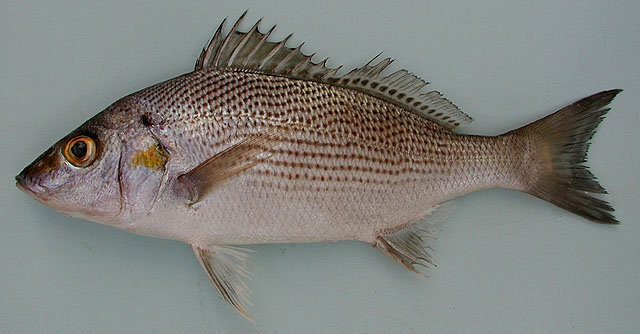| Haemulidae (Grunts), subfamily: Haemulinae |
| 60 cm TL (male/unsexed) |
|
demersal; freshwater; brackish; marine; depth range - 100 m, |
| Eastern Atlantic: west coast of Africa, from Mauritania (Ref. 7376, 57395) to southern Angola (Ref. 2799, 57395). |
|
Dorsal spines (total): 11-12; Dorsal soft rays (total): 15-17; Anal spines: 3-3; Anal soft rays: 8-9; Vertebrae: 27. Diagnosis: body oblong and compressed, not very deep (Ref. 57395). Snout short and pointed (Ref. 57395), obtuse (Ref. 81655), distinctly longer than eye diameter (Ref. 57395). 2 anterior pores on chin, followed by a median pit bearing openings of another pair of pores (Ref. 57395). A deep groove (Ref. 57395) and a pore above maxilla, below the preorbital bone (Ref. 57395, 81655). Last dorsal spine longer than penultimate one (Ref. 81655). Second anal fin spine longer and stouter than third (Ref. 57395, 81655), third anal spine may also be thick but always shorter (Ref. 81655). Caudal fin slightly forked; scales slightly ctenoid; 4-5 scale rows between lateral line and middle of spinous dorsal-fin base; swim bladder simple, without anterior horns (Ref. 57395). 11-13/1/3-6 (total 16-20) gill rakers on first gill arch; 6-7 scales on upper part of transverse series; 20-22 scales around middle of caudal peduncle (Ref. 81655).
Coloration: silvery, with round, dark brown or black and irregularly scattered spots following scale rows on back and sides (Ref. 57395, 81655). Small-sized specimens <60 mm SL may lack spots, from this size on spots gradually become visible and pattern is well-developed in specimens of about 100 mm SL or larger; no spot on snout (Ref. 81655). Black opercular spot present at angle of opercle (Ref. 57395, 81655). Dorsal and caudal fins grey (Ref. 57395). |
| Inhabit sandy and muddy bottoms of coastal waters and estuaries (Ref. 2683). Sometimes found in freshwater (Ref. 2135, 57395, 81655). Feeds on fish (Ref. 28587) and (benthic) crustaceans (Ref. 28587, 81655) as well as on mollusks and worms (Ref. 27121, 81655). Breeds in brackish water lagoons and estuaries, and even freshwaters (Ref. 57395). Of all grunts found in the continental waters of Lower Guinea, this species is found farthest upstream and seems best adapted to freshwater environments (Ref. 81655). |
|
Least Concern (LC); Date assessed: 15 May 2013 Ref. (130435)
|
| harmless |
Source and more info: www.fishbase.org. For personal, classroom, and other internal use only. Not for publication.

